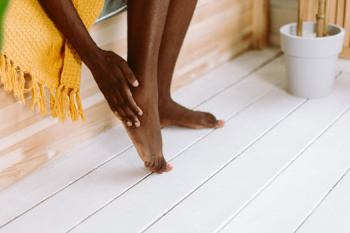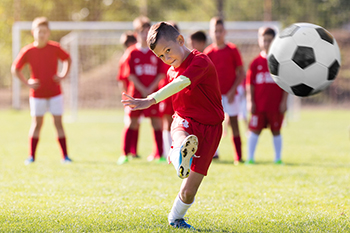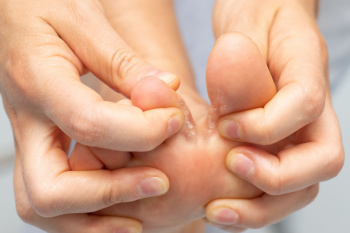Kirksville (660) 665-9000
February 2024
Peroneal Tendon Injury From Playing Tennis

An ankle sprain is the most common sudden injury in tennis, making up about 20 to 25 percent of all injuries. An ankle sprain generally occurs when the foot twists unnaturally, often when it is bent down and turned inward. This can hurt the ligaments on the outside of the ankle the most. But sometimes, an ankle sprain can cause other problems in the leg. One of these is a peroneal tendon injury. These tendons help stabilize the ankle and foot. When they are injured, it can be painful and affect how well you move. If you have hurt your ankle playing tennis, it is suggested that you schedule an appointment with a podiatrist who will examine your ankle and determine if there is peroneal tendon damage in addition to an ankle sprain. Proper treatment and healing will ensue from the diagnosis.
Sports related foot and ankle injuries require proper treatment before players can go back to their regular routines. For more information, contact Deborah Holte, DPM of Northeast Missouri Foot Clinic. Our doctor can provide the care you need to keep you pain-free and on your feet.
Sports Related Foot and Ankle Injuries
Foot and ankle injuries are a common occurrence when it comes to athletes of any sport. While many athletes dismiss the initial aches and pains, the truth is that ignoring potential foot and ankle injuries can lead to serious problems. As athletes continue to place pressure and strain the area further, a mild injury can turn into something as serious as a rupture and may lead to a permanent disability. There are many factors that contribute to sports related foot and ankle injuries, which include failure to warm up properly, not providing support or wearing bad footwear. Common injuries and conditions athletes face, including:
- Plantar Fasciitis
- Plantar Fasciosis
- Achilles Tendinitis
- Achilles Tendon Rupture
- Ankle Sprains
Sports related injuries are commonly treated using the RICE method. This includes rest, applying ice to the injured area, compression and elevating the ankle. More serious sprains and injuries may require surgery, which could include arthroscopic and reconstructive surgery. Rehabilitation and therapy may also be required in order to get any recovering athlete to become fully functional again. Any unusual aches and pains an athlete sustains must be evaluated by a licensed, reputable medical professional.
If you have any questions please feel free to contact our office located in Kirksville, MO . We offer the newest diagnostic and treatment technologies for all your foot and ankle needs.
What to Expect During Ingrown Toenail Surgery
 Ingrown toenail surgery, also known as partial nail avulsion, is a common procedure performed to treat ingrown toenails. It is often used for more severe cases of ingrown toenails, which do not respond to other conservative healing methods. During the surgery, the podiatrist administers local anesthesia to numb the toe, ensuring the patient's comfort throughout the procedure. Next, the podiatrist carefully removes a portion of the affected toenail, including the ingrown edge or spike that is causing pain and inflammation. This process may involve using surgical instruments or specialized tools to precisely trim the nail. For recurrent or severe cases, the podiatrist may also apply a chemical solution or use a laser to destroy the nail matrix, the area the nail grows from, to prevent the ingrown portion of the nail from regrowing. Then the toe is thoroughly cleaned. A sterile dressing may be applied to promote healing. The entire procedure typically takes less than an hour, and patients can usually resume normal activities shortly afterward. If you have an ingrown toenail, it is suggested that you consult a podiatrist who can offer correct treatment options, which may include surgery.
Ingrown toenail surgery, also known as partial nail avulsion, is a common procedure performed to treat ingrown toenails. It is often used for more severe cases of ingrown toenails, which do not respond to other conservative healing methods. During the surgery, the podiatrist administers local anesthesia to numb the toe, ensuring the patient's comfort throughout the procedure. Next, the podiatrist carefully removes a portion of the affected toenail, including the ingrown edge or spike that is causing pain and inflammation. This process may involve using surgical instruments or specialized tools to precisely trim the nail. For recurrent or severe cases, the podiatrist may also apply a chemical solution or use a laser to destroy the nail matrix, the area the nail grows from, to prevent the ingrown portion of the nail from regrowing. Then the toe is thoroughly cleaned. A sterile dressing may be applied to promote healing. The entire procedure typically takes less than an hour, and patients can usually resume normal activities shortly afterward. If you have an ingrown toenail, it is suggested that you consult a podiatrist who can offer correct treatment options, which may include surgery.
Foot surgery is sometimes necessary to treat a foot ailment. To learn more, contact Deborah Holte, DPM of Northeast Missouri Foot Clinic. Our doctor will assist you with all of your foot and ankle needs.
When Is Surgery Necessary?
Foot and ankle surgery is generally reserved for cases in which less invasive, conservative procedures have failed to alleviate the problem. Some of the cases in which surgery may be necessary include:
- Removing foot deformities like bunions and bone spurs
- Severe arthritis that has caused bone issues
- Cosmetic reconstruction
What Types of Surgery Are There?
The type of surgery you receive will depend on the nature of the problem you have. Some of the possible surgeries include:
- Bunionectomy for painful bunions
- Surgical fusion for realignment of bones
- Neuropathy decompression surgery to treat nerve damage
Benefits of Surgery
Although surgery is usually a last resort, it can provide more complete pain relief compared to non-surgical methods and may allow you to finally resume full activity.
Surgical techniques have also become increasingly sophisticated. Techniques like endoscopic surgery allow for smaller incisions and faster recovery times.
If you have any questions please feel free to contact our office located in Kirksville, MO . We offer the newest diagnostic and treatment technologies for all your foot and ankle needs.
Choosing the Right Cleats for Your Child

When choosing cleats for your child's sport, it is essential to prioritize both their performance and foot health. Traditional studded cleats, especially those with only two heel studs, can make conditions like Sever’s disease worse by increasing pressure under the heel. Opt for cleats with four or more heel studs. All purpose turf-style cleats can help distribute weight-bearing forces more evenly and alleviate discomfort. Football cleats, while popular, may pose risks in sports like soccer, due to their distal toe stud, although they are functionally similar to lacrosse cleats. Soccer cleats, known for agility, often lack support and padding, which may be problematic for children with loose ligaments. Additionally, the thin and flexible soleplates of soccer cleats may not provide sufficient support, especially for those requiring arch support. Baseball cleats, subject to league regulations, may feature metal spikes, requiring attention to player safety during slides. Turf cleats emerge as a versatile option, offering better support, traction, and weight distribution across the foot. If your child is experiencing foot, toe, or ankle pain related to their sports activity, it is suggested that you schedule an appointment with a podiatrist to detect the cause and offer guidance on footwear choices as well as treatment options.
Making sure that your children maintain good foot health is very important as they grow. If you have any questions, contact Deborah Holte, DPM of Northeast Missouri Foot Clinic. Our doctor can provide the care you need to keep you pain-free and on your feet.
Keeping Children's Feet Healthy
Having healthy feet during childhood can help prevent medical problems later in life, namely in the back and legs. As children grow, their feet require different types of care. Here are some things to consider...
Although babies do not walk yet, it is still very important to take care of their feet.
Avoid putting tight shoes or socks on his or her feet.
Allow the baby to stretch and kick his or her feet to feel comfortable.
As a toddler, kids are now on the move and begin to develop differently. At this age, toddlers are getting a feel for walking, so don’t be alarmed if your toddler is unsteady or ‘walks funny’.
As your child gets older, it is important to teach them how to take care of their feet.
Show them proper hygiene to prevent infections such as fungus.
Be watchful for any pain or injury.
Have all injuries checked by a doctor as soon as possible.
Comfortable, protective shoes should always be worn, especially at play.
If you have any questions please feel free to contact our office located in Kirksville, MO . We offer the newest diagnostic and treatment technologies for all your foot and ankle needs.
What Happens if Athlete's Foot Is Untreated
 Athlete’s foot is a fungal infection that causes blisters and peeling skin on the feet. This contagious infection is generally treated with topical antifungal medications. If left untreated, athlete's foot can lead to more severe problems than the itching and redness associated with the infection. If ignored, the infection can spread to other parts of the foot, such as the toenails or the soles of the feet. As the condition progresses, it may result in painful blisters, cracks, and open sores, making daily activities like walking or standing uncomfortable. In some cases, untreated athlete's foot can contribute to the development of secondary bacterial infections, which can include swollen and painful feet. These secondary infections can also cause fever and lymph node infections. Some patients also experience allergic reactions to the initial fungal infection, causing blisters on the infected area. Podiatrists can prescribe antifungal medications and provide more information on foot hygiene to effectively quell a case of athlete’s foot. If you suspect you have athlete’s foot, it is suggested that you seek prompt treatment from a podiatrist to treat the infection and prevent it from worsening.
Athlete’s foot is a fungal infection that causes blisters and peeling skin on the feet. This contagious infection is generally treated with topical antifungal medications. If left untreated, athlete's foot can lead to more severe problems than the itching and redness associated with the infection. If ignored, the infection can spread to other parts of the foot, such as the toenails or the soles of the feet. As the condition progresses, it may result in painful blisters, cracks, and open sores, making daily activities like walking or standing uncomfortable. In some cases, untreated athlete's foot can contribute to the development of secondary bacterial infections, which can include swollen and painful feet. These secondary infections can also cause fever and lymph node infections. Some patients also experience allergic reactions to the initial fungal infection, causing blisters on the infected area. Podiatrists can prescribe antifungal medications and provide more information on foot hygiene to effectively quell a case of athlete’s foot. If you suspect you have athlete’s foot, it is suggested that you seek prompt treatment from a podiatrist to treat the infection and prevent it from worsening.
Athlete’s Foot
Athlete’s foot is often an uncomfortable condition to experience. Thankfully, podiatrists specialize in treating athlete’s foot and offer the best treatment options. If you have any questions about athlete’s foot, consult with Deborah Holte, DPM from Northeast Missouri Foot Clinic. Our doctor will assess your condition and provide you with quality treatment.
What Is Athlete’s Foot?
Tinea pedis, more commonly known as athlete’s foot, is a non-serious and common fungal infection of the foot. Athlete’s foot is contagious and can be contracted by touching someone who has it or infected surfaces. The most common places contaminated by it are public showers, locker rooms, and swimming pools. Once contracted, it grows on feet that are left inside moist, dark, and warm shoes and socks.
Prevention
The most effective ways to prevent athlete’s foot include:
- Thoroughly washing and drying feet
- Avoid going barefoot in locker rooms and public showers
- Using shower shoes in public showers
- Wearing socks that allow the feet to breathe
- Changing socks and shoes frequently if you sweat a lot
Symptoms
Athlete’s foot initially occurs as a rash between the toes. However, if left undiagnosed, it can spread to the sides and bottom of the feet, toenails, and if touched by hand, the hands themselves. Symptoms include:
- Redness
- Burning
- Itching
- Scaly and peeling skin
Diagnosis and Treatment
Diagnosis is quick and easy. Skin samples will be taken and either viewed under a microscope or sent to a lab for testing. Sometimes, a podiatrist can diagnose it based on simply looking at it. Once confirmed, treatment options include oral and topical antifungal medications.
If you have any questions, please feel free to contact our office located in Kirksville, MO . We offer the newest diagnostic and treatment technologies for all your foot care needs.





